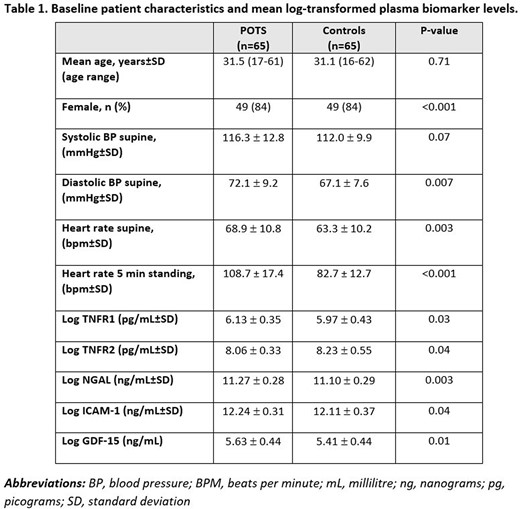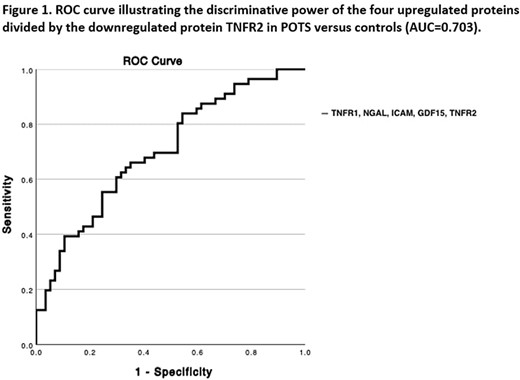-
PDF
- Split View
-
Views
-
Cite
Cite
S Nawaz, A Larsson, V Hamrefors, T Ruge, R Sutton, B Olshansky, A Fedorowski, M Johansson, Novel inflammatory biomarkers in postural orthostatic tachycardia syndrome, EP Europace, Volume 25, Issue Supplement_1, June 2023, euad122.225, https://doi.org/10.1093/europace/euad122.225
Close - Share Icon Share
Abstract
Type of funding sources: None.
Postural Orthostatic Tachycardia Syndrome (POTS) is a disorder characterized by excessive orthostatic tachycardia and orthostatic intolerance. While traditional inflammatory biomarkers tend to be normal, a subclinical inflammatory process may be present in POTS.
We aimed to analyse novel inflammatory biomarkers in POTS patients: Growth Differentiation Factor 15 (GDF15), Neutrophil Gelatinase Associated Lipocalin (NGAL), Intercellular Adhesion Molecule 1 (ICAM-1), Tumour Necrosis Factor Receptor 1 (TNFR1) and Tumour Necrosis Factor Receptor 2 (TNFR2) and compared them to healthy controls. These inflammatory biomarkers have been shown to be independent predictors of major adverse cardiovascular events in other populations.
An age- and sex-matched case-control study included 65 patients verified to have POTS by positive head-up tilt-testing and cardiovascular autonomic tests, and 65 healthy controls (mean age: 31.1 vs 31.5 years, 84% females) with negative active standing tests and no history of syncope, orthostatic intolerance, or endocrine disease. High-sensitivity chemiluminescence sandwich immunoassay was used to measure plasma levels of inflammatory biomarkers in a blinded fashion. Descriptive statistics compared groups and a univariate ANOVA was employed. Biomarker values were log-transformed. A score incorporating all biomarkers was generated to see if the totality of biomarkers discriminated POTS patients from controls.
Baseline characteristics are displayed in Table 1. Mean levels of GDF15 (p=0.01), NGAL (p=0.003), ICAM-1 (p=0.04) and TNFR1 (p=0.03) were significantly higher in POTS vs controls, whereas TNFR2 (p=0.04) was significantly lower in POTS (p=0.04). The product of four upregulated biomarkers divided by TNFR2 produced a receiver operator curve (ROC) with an area under the curve (AUC) of 0.703 (p<0.001) (Fig.1).
POTS patients had increased GDF15, NGAL, TNFR1 and ICAM-1 levels and reduced TNFR2 levels suggesting underlying, yet undefined, subclinical inflammatory processes involving neutrophil and endothelial activation.

Study characteristics

Discriminative power of proteins
- tachycardia
- syncope
- inflammatory markers
- endocrine system diseases
- autonomic nervous system
- area under curve
- biological markers
- cardiovascular system
- chemiluminescence
- endothelium
- immunoassay
- intercellular adhesion molecule 1
- neutrophils
- plasma
- tumor necrosis factor receptor
- postural orthostatic tachycardia syndrome
- cardiovascular event
- growth differentiation factor 15
- descriptive statistics
- lipocalin-2 protein
- orthostatic intolerance
- receptors, tumor necrosis factor, type ii
- verification



